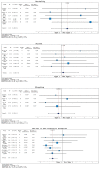A Meta-Analysis of Short-Term Outcomes of TAVR versus SAVR in Bicuspid Aortic Valve Stenosis and TAVR Results in Different Bicuspid Valve Anatomies
- PMID: 38068423
- PMCID: PMC10707011
- DOI: 10.3390/jcm12237371
A Meta-Analysis of Short-Term Outcomes of TAVR versus SAVR in Bicuspid Aortic Valve Stenosis and TAVR Results in Different Bicuspid Valve Anatomies
Abstract
Background: To provide a comprehensive analysis of the current literature comparing the outcomes of surgical aortic valve replacement (SAVR) and transcatheter aortic valve replacement (TAVR) in patients with bicuspid aortic stenosis (BAS), with particular attention to BAV morphology in patients undergoing TAVR.
Methods: Following PRISMA guidelines, all relevant articles with no design restrictions from PubMed, CCTR (Cochrane Controlled Trials Register), and Google Scholar were screened for inclusion. Studies were included if they reported clinical endpoints for SAVR and TAVR or, in BAS treated with TAVR, for type 1 and non-type 1 morphology. Odds ratio and Cohen's D were considered as effect size measurements for qualitative and quantitative variables, respectively.
Results: A total of eight studies comparing short-term outcomes between SAVR and TAVR and nine studies with outcomes data between type 1 and non-type 1 BAS treated with TAVR were considered for the final analysis. No statistically significant difference was found for what concerns the rates of death, stroke, and acute kidney injury between SAVR and TAVR. In comparison to patients undergoing SAVR, the incidence of PPI (permanent pacemaker implantation) was greater in the TAVR group (OR 0.35, 95% CI 0.15-0.79, p = 0.01), and the frequency of bleeding events was found to be higher among patients undergoing SAVR (OR 4.3, 95% CI 2.9-6.4, p < 0.001). The probabilities of 30-day mortality, stroke, and any bleeding were not significantly affected by bicuspid valve morphology in TAVR patients. PPI or development of new conduction anomalies was found to be more frequent in type 1 anatomies (OR 0.46, 95% CI 0.30-0.70, p <0.001). Mildly lower post-procedural transprothesic gradients were found in patients with type 1 morphology.
Conclusions: In BAS patients, TAVR has comparable short-term outcomes rates with SAVR, but higher PPI rates and lower incidence of bleeding events. In patients undergoing TAVR, type 1 BAS is associated with lower postoperative transvalvular gradients but higher PPI rates and conduction abnormalities.
Keywords: SAVR; TAVR; bicuspid aortic valve; outcomes; type.
Conflict of interest statement
The authors declare no conflict of interest.
Figures







References
-
- I Michelena H., Della Corte A., Evangelista A., Maleszewski J.J., Edwards W.D., Roman M.J., Devereux R.B., Fernández B., Asch F.M., Barker A.J., et al. International consensus statement on nomenclature and classification of the congenital bicuspid aortic valve and its aortopathy, for clinical, surgical, interventional and research purposes. Eur. J. Cardio-Thoracic Surg. 2021;60:448–476. doi: 10.1093/ejcts/ezab038. - DOI - PubMed
Publication types
LinkOut - more resources
Full Text Sources

